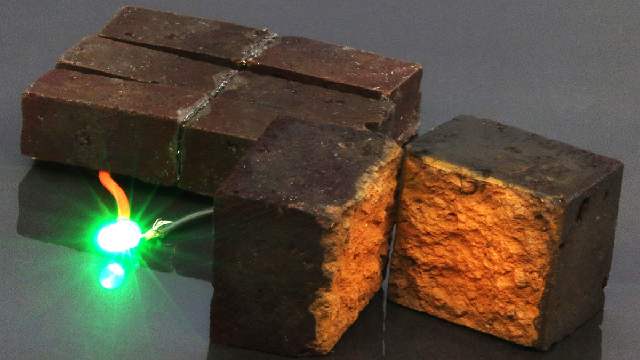Chemists create ‘smart bricks’ for energy storage.
This short article is suitable for year 8 and 10 chemistry and physics students. It demonstrates the importance of an understanding of energy storage and chemical properties in the development of technologies that could help society.
Word Count: 320

The humble house brick could one day help power electronic devices, if researchers at Washington University, US, are on the money.
In a proof-of-concept paper in the journal Nature Communications, they describe how regular red bricks (and they have to be red) can be converted into “supercapacitors”, which can be charged to hold electricity until it’s needed, much like a battery.
They make use of the porous structure of a brick to “vapour deposit” a layer of a conducting polymer, converting it into an energy-storing electrode.
“In this work, we have developed a coating of the conducting polymer PEDOT, which is comprised of nanofibres that penetrate the inner porous network of a brick; a polymer coating remains trapped in a brick and serves as an ion sponge that stores and conducts electricity,” says co-author Julio D’Arcy.
The colour of bricks is important because, they say, the red pigment – iron oxide – is essential for triggering the polymerisation reaction.
And according to their calculations, walls made from these smart bricks could store a substantial amount of energy and be recharged when needed.
“PEDOT-coated bricks are ideal building blocks that can provide power to emergency lighting,” D’Arcy says.
“We envision that this could be a reality when you connect our bricks with solar cells: this could take 50 bricks in close proximity to the load. These 50 bricks would enable powering emergency lighting for five hours.
“Advantageously, a brick wall serving as a supercapacitor can be recharged hundreds of thousands of times within an hour. If you connect a couple of bricks, microelectronics sensors would be easily powered.”
The researchers suggest their method could inspire the development of multi-purpose construction materials that have the ability to store electricity and power various devices.
“Our supercapacitor technology adds value to a ‘dirt-cheap’ construction material and demonstrates a scalable process affording energy storage for powering embedded microdevices in architectural applications that utilise fired brick,” they write.
This article is originally published by Cosmos as Plug it into the wall.
Login or Sign up for FREE to download a copy of the full teacher resource





